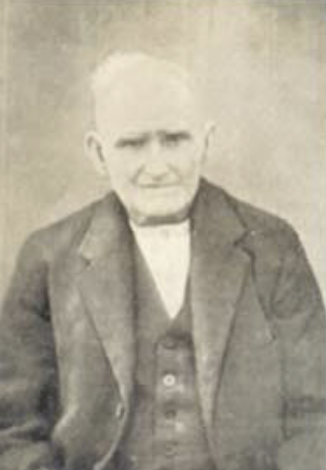Niall Mac Giolla Bhríde, born in 1861 in Feymore, Creeslough, is celebrated as one of Donegal’s most revered poets and songwriters. Known for his contributions to the preservation of the Irish language and culture, he became a pivotal figure in the Irish literary revival of the early 20th century. His poetry and songs, often centered on themes of emigration, rural life, and Irish cultural identity, continue to resonate with audiences in Ireland and among the Irish diaspora. One of his most famous works, the ballad “Noreen Bawn,” remains a beloved part of Ireland’s rich folk music tradition.
The Enduring Legacy of “Noreen Bawn”
“Noreen Bawn” is perhaps the most famous of Mac Giolla Bhríde’s compositions. Written in the early 20th century, the ballad tells the poignant story of a young Irish woman who leaves her homeland in search of a better life, only to return home ill and die. The song struck a deep chord with many Irish emigrants and their families, reflecting the emotional pain of leaving one’s homeland and the harsh realities of life abroad. Its evocative portrayal of loss and longing made it one of the most cherished Irish ballads of its time, and it continues to be performed and remembered today.
For many in the Irish diaspora, “Noreen Bawn” became an anthem that spoke to their experiences of separation from family, home, and culture. Mac Giolla Bhríde’s ability to capture these emotions in song made him an essential voice of his generation.
A Pillar of the Gaelic Revival
In addition to his songwriting, Mac Giolla Bhríde played a crucial role in Ireland’s Gaelic Revival, a movement dedicated to revitalizing Irish language and culture. In 1901, he helped establish the Gaelic League in Donegal, a cultural organization that aimed to preserve and promote the Irish language. Through his efforts, the language and its traditions were sustained in the face of growing Anglicization, particularly in rural areas like Donegal.
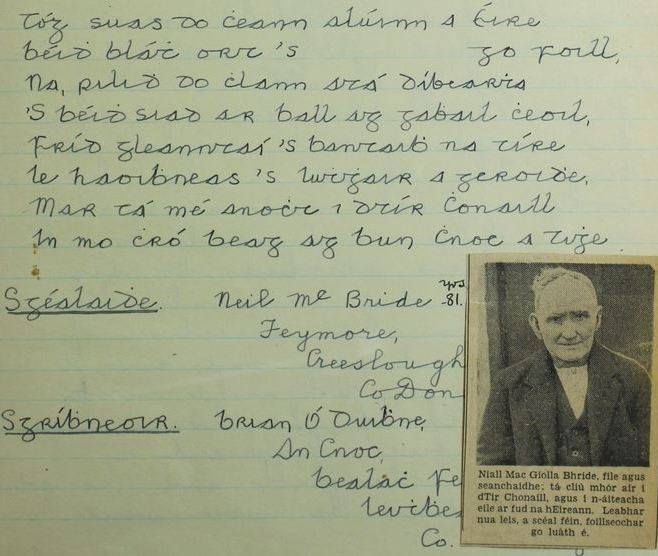
His 1905 collection of poems, Blátha Fraoich (Heather Blossoms), became well-known across Ireland, solidifying his reputation as a master of Irish verse. Among his best-known songs, alongside “Noreen Bawn,” are “The Hills of Donegal,” “The Castle of Doe,” “Marble Hill,” and “Mo Chró Beag ag Bun Chnoc a’ Tighe.” Each of these works reflects his deep connection to the landscape, people, and cultural heritage of his native Donegal.
Defending Irish Identity in the Courtroom
Mac Giolla Bhríde’s commitment to the Irish language was not just artistic but also political. In 1905, he found himself at the center of a legal battle when he was fined for displaying his name in Irish on the back of his cart—a violation of British laws that required signage to be in English. The incident occurred on the evening of March 11, 1905, when Mac Giolla Bhríde was stopped by a policeman after attending a fair in Dunfanaghy. The policeman issued him a fine of one shilling, but Mac Giolla Bhríde refused to pay, arguing that the Irish language should be recognised in public life.
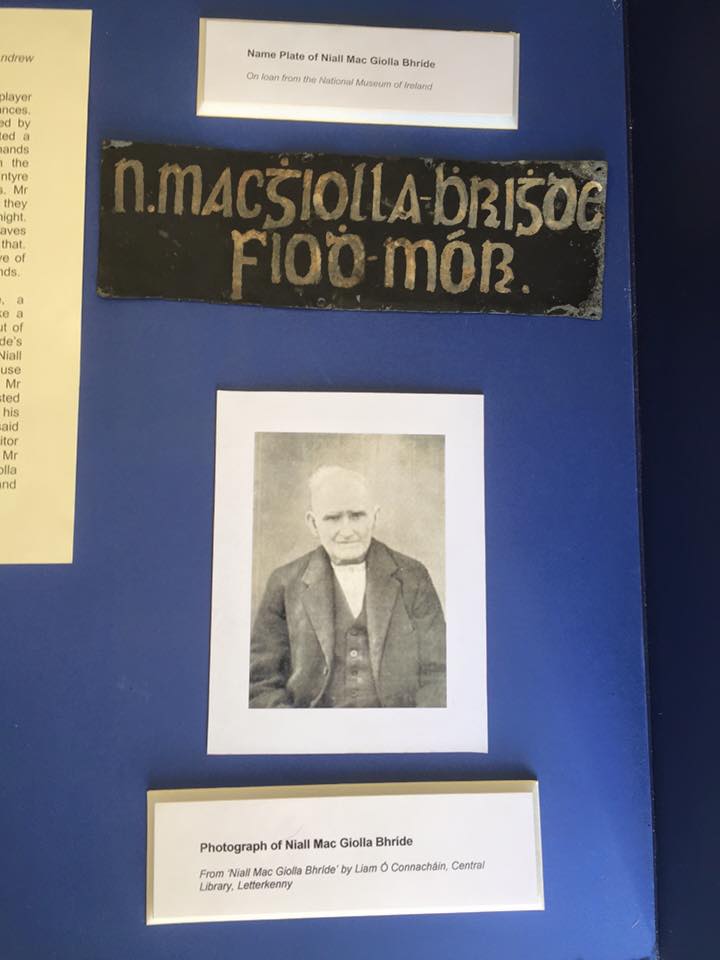
The case was widely covered by both local and national newspapers, drawing the attention of the Gaelic League, which rallied to his defense. Patrick Pearse, a prominent member of the League who would later become one of the leaders of the 1916 Easter Rising, agreed to represent Mac Giolla Bhríde in court, seeing the case as an opportunity to promote Irish nationalism. Although the case was ultimately lost, with Mac Giolla Bhríde being fined an additional shilling, it sparked national outrage and galvanized support for the recognition of the Irish language in public life.
Pearse wrote about the case in the Gaelic League’s newspaper An Claidheamh Soluis (The Sword of Light), lamenting that the court’s decision effectively placed Irish on the same level as foreign languages like Yiddish. This case not only highlighted the legal struggles faced by Irish speakers but also inspired Pearse and others to continue their fight for Irish independence.
Read arguments in Niall Mac Giolla Bhrighde’s Case from the Irish Times from May 17 1905.
A Lasting Influence
Niall Mac Giolla Bhríde lived through a transformative period in Irish history, witnessing the Irish Revival, the struggle for independence, and the cultural changes that followed. He passed away in 1942, leaving behind a legacy of poetry and song that continues to be cherished today. His works remain a testament to the power of language and art in shaping national identity and preserving cultural heritage.
In recognition of his contributions, a plaque was unveiled in his honor at the entrance to Doe Graveyard on October 3, 1982. Additionally, the nameplate from Mac Giolla Bhríde’s cart, the one that led to his infamous court case, is now on permanent display at the Donegal County Museum in Letterkenny—a symbol of his dedication to the Irish language and the cultural revival that defined his life’s work.
Mac Giolla Bhríde’s life and legacy are emblematic of the resilience of Irish culture, a reminder of the power of language, music, and poetry to preserve identity in the face of adversity. Through his contributions, both artistic and political, he ensured that the Irish language would not only survive but thrive, serving as an enduring symbol of Ireland’s rich cultural heritage.
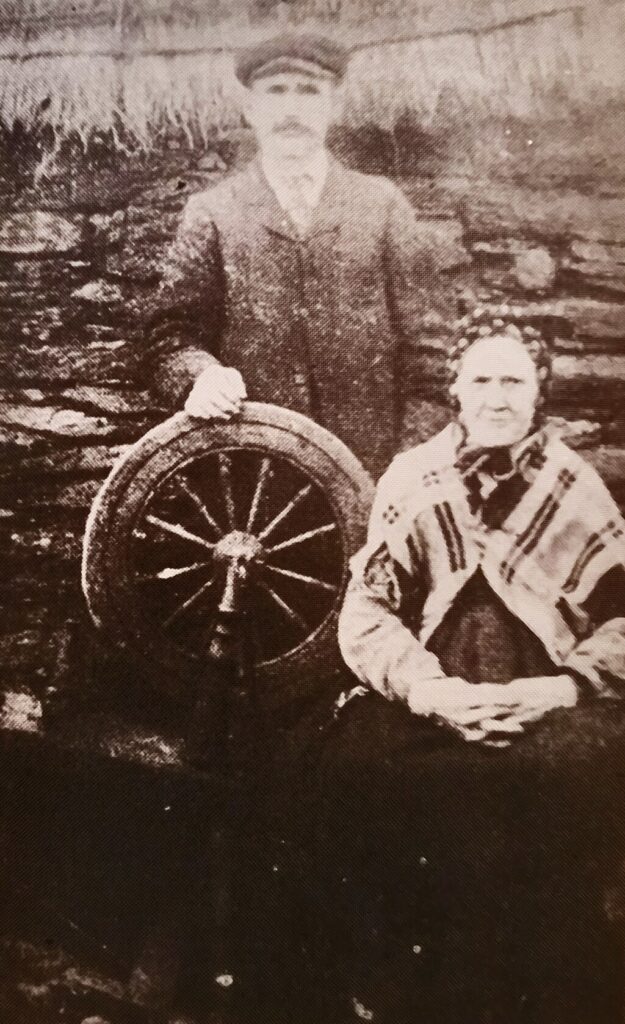
Below is the famous song called Turlough Óg Ó Baoill about the Mc Sweeney Clan who lived in Doe Castle.
Turlough Óg Ó Baoill
Wild are thy hills, O Donegal, that growing darkly rise
As if to greet the mist that falls upon them from the skies;
Dark, dark thy hills and darker still thy mountain torrents flow,
But darker still Maolmuire’s heart in his Castle Hall at Doe.
Stout are thy oaks, O Donegal, and straight thy ashen tree,
And swift and strong thy sons so tall thy country’s pride to see;
But oak or ash or young men all that sprung from Irish soil,
Were not more stout, swift, straight and tall than the chief of Clan O’Boyle.
air are thy plains, O’Donegal, and calm thy winding streams
That gently flow by hut and hall beneath the bright sunbeams;
But plain or stream or meadow green or flower upon the lea(?),
Were not more mild than Maolmuire’s child, so sweet and fair was she.
Boyle was the pride of Faugher side near the hills of Ballymore,
For feats of strength, none equalled him from Fanad to Gweedore,
And he would go through frost and snow on the merry Christmas Day
With ringing cheer to hunt the deer from his haunts in dark Glenveagh.
In his little boat O’Boyle would float, a fishing he would go,
With hook and line to Lackagh stream that flows near Castle Doe.
High in the Castle tower his loved one lay confined,
And on the lofty battlements in sorrow deep she pined.
At the Castle strand two boats were manned to wait the rising tide,
Maolmuire there in chief command right cowardly did hide;
And when O’Boyle his homeward course steered by the Bishop’s Isle,
He was waylaid and a prisoner made of fearless young O’Boyle.
They brought him to the Castle, in strong irons he was bound,
And by Maolmuire was confined in a dungeon underground;
But on a few days after, inside the graveyard wall,
Four stalwart ruffians bore a bier wrapped in a funeral pall.
Poor Aileen from her tower above beheld the mournful scene,
In mute amaze she cast her gaze on the Castle graveyard green,
All pale in death beside a mound of freshly risen soil,
The pall removed, she there beheld the features of O’Boyle.
Then with a shriek she madly leaped from the tower to the ground,
Where by her faithful waiting maid her corpse all cold was found.
And in Doe Castle’s graveyard green beneath the mouldering soil,
Maolmuire’s daughter sleeps in death with Turlough Og O’Boyle.
Check out entries by Mac Giolla Bhride to the Duchas National Folklore Collection
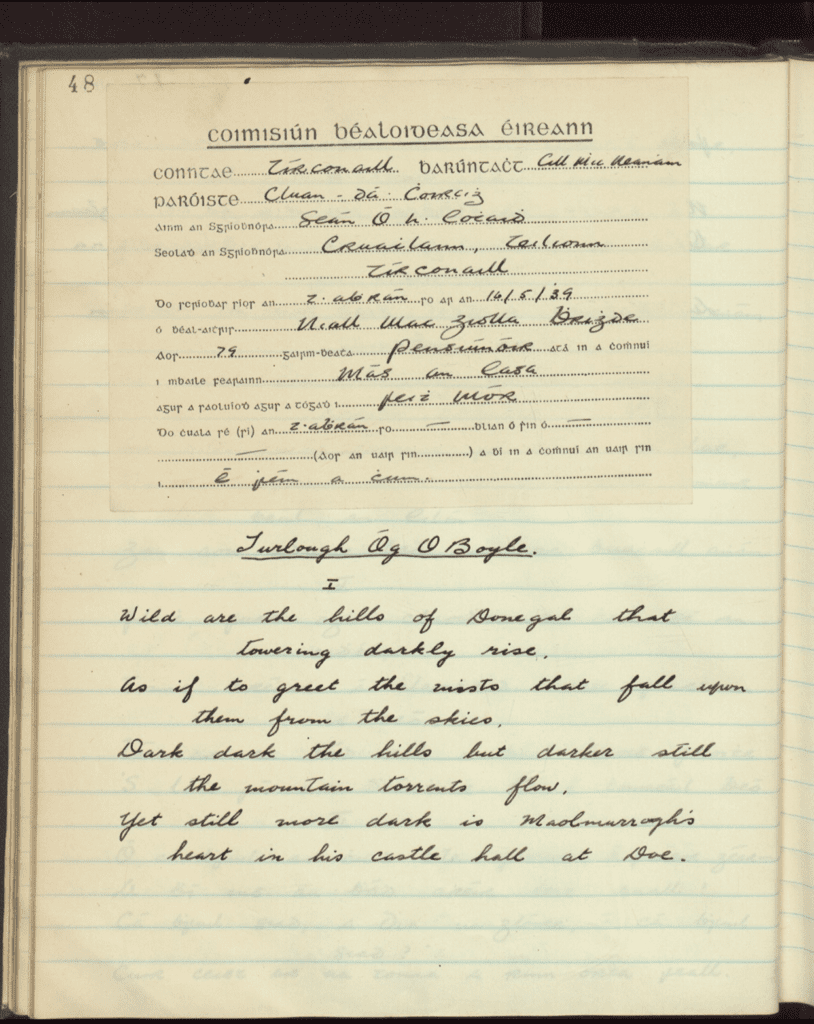
You can read Entries gathered from Niall Mc Bride in the 1930s in the National Folklore Collection. It includes folklore from the Creeslough area and excerpts from his songs.
Read our article on Noreen Bawn’s cottage where Bridget Gallagher who Mac Giolla Bhride used as inspiration for his famous song Noreen Bawn, lived.

